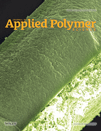Pattern formation and morphology in the course of drying a droplet of a ternary polymer solution
Abstract
A micro-structured polymer film was prepared by drying a droplet of a ternary polymer solution of polystyrene (PS), poly(vinyl pyrrolidone) (PVP), and chloroform. Within a certain weight ratio of PS to PVP an ordered pattern of cylindrical PVP domains was formed on the film surface. The diameter of the individual PVP domains was in the order of 2–3 μm. The effect of polymer weight ratios on the surface morphology was investigated by atomic force microscopy. Additionally, scanning electron microscopy of cross-sections of the polymer composite film yielded supplementary information on the bulk morphology and revealed an unexpected complex structure underneath the surface pattern. The reasons for this formation mechanism possibly included aspects of phase separation, convective transport in a drying droplet, and the continuous increase of viscosity during solvent evaporation. At a certain solvent concentration in the evaporation path, it will lead to a vitrification of any structure. The “evolution time”, the time between the onset of phase separation and this “point of vitrification”, will determine the resulting film morphology. © 2012 Wiley Periodicals, Inc. J. Appl. Polym. Sci., 2013




